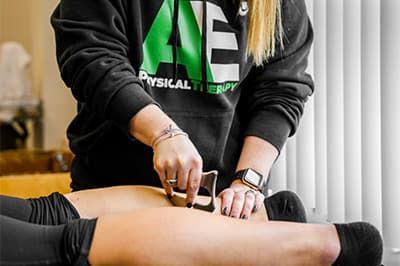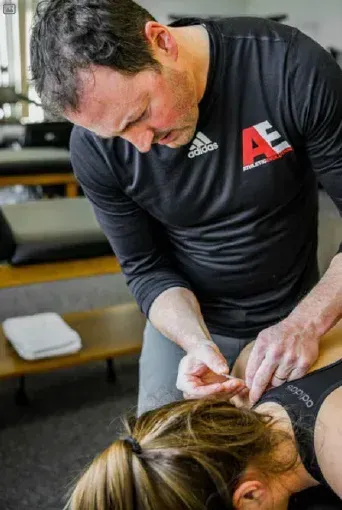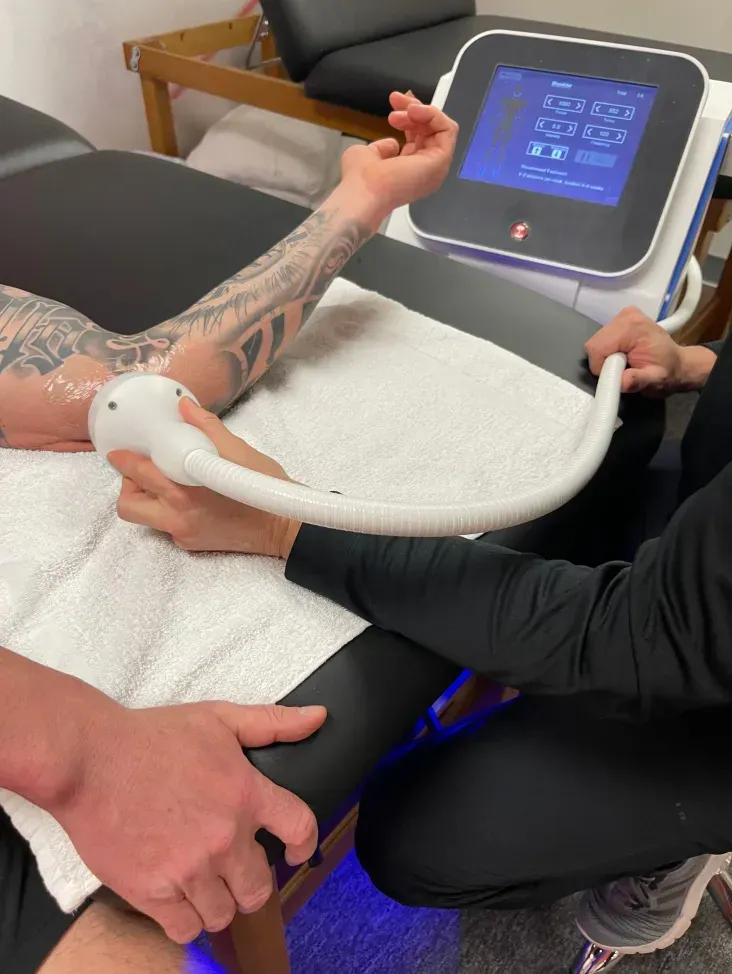What Is Shockwave Therapy?
Shockwave therapy, also known as Extracorporeal Shockwave Therapy (ESWT), is a safe, non-invasive treatment designed to jumpstart your body’s natural healing process. It uses focused sound waves to target pain and inflammation right at the source.
This advanced therapy is especially effective for chronic conditions like tendon injuries, plantar fasciitis, and fractures that are slow to heal. By delivering gentle pulses of energy to the affected area, shockwave therapy can help reduce pain, boost circulation, and support long-lasting tissue repair—so you can get back to doing what you love, faster.
Ready to feel better and move stronger?
Effectiveness
ESWT has shown promise in reducing pain and promoting healing in various conditions, with success rates ranging from 60% to 80% for conditions like tendinopathies and plantar fasciitis.
Treatment process
- The treatment is typically performed in a series of sessions, with the number and frequency varying depending on the condition and individual response.
- A device is used to deliver the shockwaves to the targeted area, and the intensity of the waves can be adjusted to the patient’s pain tolerance.
Conditions treated
- Sports injuries: Plantar fasciitis, Achilles tendonitis, patellar tendinopathy, and other tendon and ligament injuries.
- Chronic pain: Osteoarthritis, nerve entrapment, and other conditions causing chronic pain.
- Other conditions: Bone non-union (non-healing fractures), and even erectile dysfunction.
Our Services

Injury Prevention / Return to Sport
Our Return to Sport Program is designed for our patients who are nearing the end of their Physical Therapy treatment at AE PT, but are either unprepared to start training on their own or could benefit from a bridge between therapy and traditional sports specific training. Too often we see patients/athletes being discharged from Physical Therapy because they can walk around pain free, but are not prepared for the athletic demands of their sport or the physical demands of their job or lifestyle. This unfortunately can lead to a set-back or another injury. Our therapists will work in conjunction with our strength coaches, using your initial evaluation, treatments, and a post treatment evaluation to essentially create a road map to lead you from therapy back to your sport. We offer a variety of return to sport programs so that our patients can choose an option that best fits what they need and want. Each program will be customized just for you, and feature our strength coaches and therapists working together to best serve you. Our team will work with you to find the best available option for you and your long term health.

Soft Tissue Massage, Myofascial Release, & Instrument Assisted
Soft tissue massage is a type of massage therapy that focuses on the manipulation of soft tissues such as muscles, tendons, ligaments, and fascia. It is a hands-on technique that is used to treat a range of physical ailments, including back pain, neck pain, headaches, sports injuries, and more.
Instrument assisted soft tissue mobilization (IASTM) is a skilled myofascial intervention used for soft-tissue treatment. It is based on the principles of cross fiber massage.
It is applied using instruments that are usually made of stainless steel with beveled edges and contours that can conform to different body anatomical locations and allows for deeper penetration. It is used for the detection and treatment of soft tissue disorders.
Instruments effectively break down fascial restrictions and scar tissue. The ergonomic design of these instruments provides the clinician with the ability to locate restrictions and allows the clinician to treat the affected area with the appropriate amount of pressure

Active Isolated & PNF Stretching
Active Isolated Stretching
This technique involves holding a stretch for two seconds at a time, and then repeating the stretch while increasing the resistance by a few degrees each time. AIS uses reciprocal inhibition, which is a two-second hold at the end of the movement pattern.
PNF stretching
This advanced flexibility training technique involves stretching and contracting the targeted muscle group. PNF stretching includes techniques like hold-relax, contract-relax, and hold-relax with agonist contraction.
Combining PNF techniques with active stretching can help increase mobility and maximize the effectiveness of both techniques. For example, you can add a series of contract-relax impulses to an active stretching exercise like the kneeling lunge

Trigger Point Release & Neuromuscular Techniques
Trigger point release, also known as trigger point therapy or myofascial release, is a massage technique that involves applying pressure to specific points in the body to relieve pain and tension

Joint mobilization and Spinal Manipulations
Joint mobilization is a physical therapy technique that involves a physical therapist manually moving a patient’s joint to improve its range of motion, reduce pain, and increase joint function.

Selective Functional Movement Assessment & Functional Movement Screen
The SFMA is a clinical model used to assist diagnosis and treatment of musculoskeletal disorders by identifying dysfunctions in movement patterns. The SFMA is meant to be used by physiotherapists / physical therapists, athletic trainers, chiropractors, and physicians.

Cupping & Dry Needling
Cupping therapy is an alternative medicine technique that uses suction to create a vacuum on the skin to promote healing.
Dry needling is a treatment that involves inserting thin needles into the skin to treat pain and movement issues.




